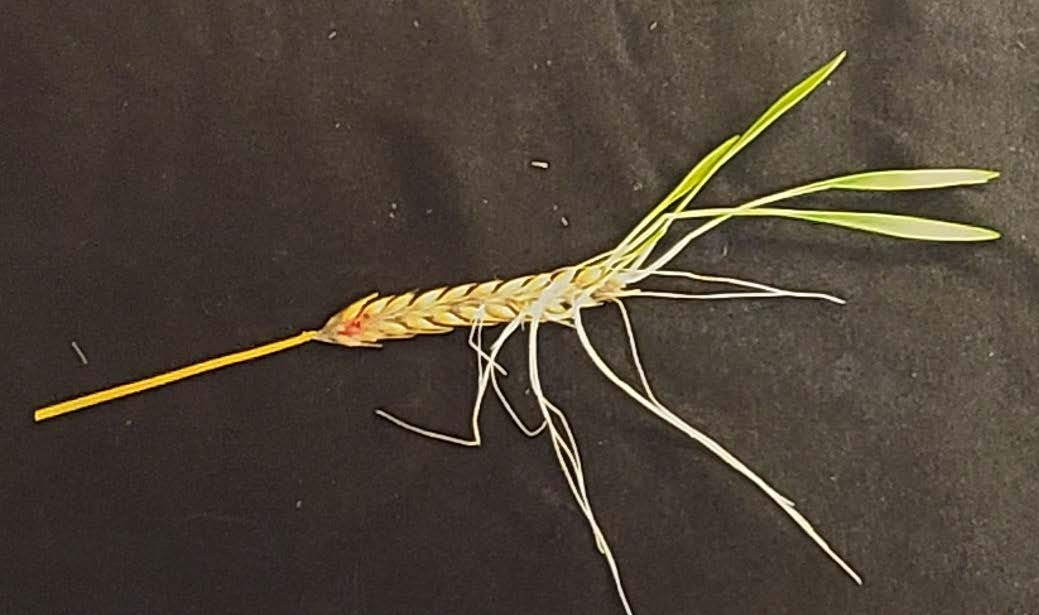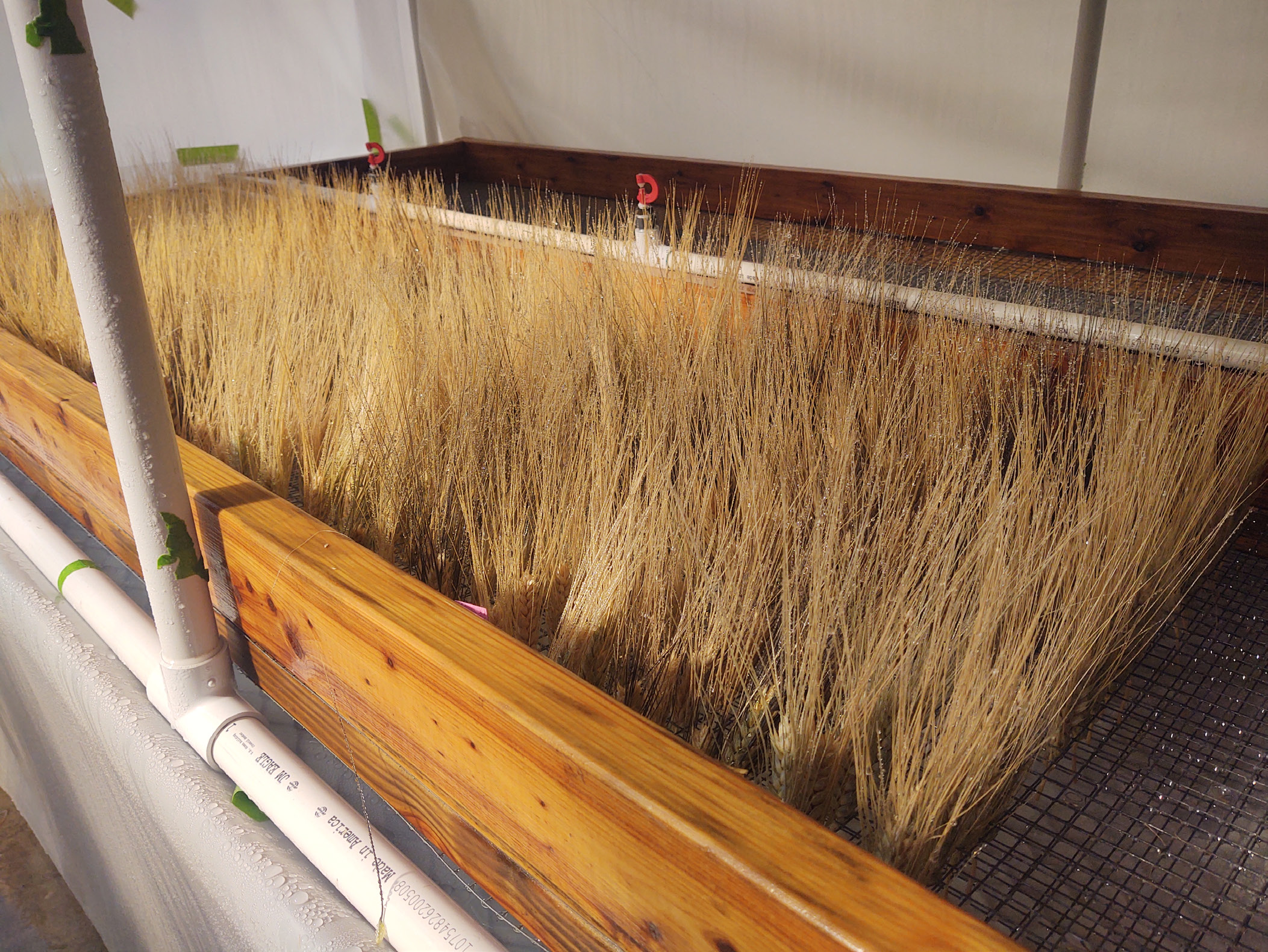An Introduction to Pre-Harvest Sprout in Wheat
Agriculture and Natural Resources
MT202403AG
New July 2024
By Brandon Tillett, PhD Candidate; Uta McKelvy, Assistant Professor in Plant Sciences and Plant Pathology and MSU Extension Plant Pathologist; Mike Giroux, Professor and Department Head in Plant Sciences and Plant Pathology
Wheat Pre-harvest Sprout (PHS) occurs when late-season rains cause grain to sprout before harvest, resulting in reduced grain quality and yield loss. Genetic factors determine susceptibility to PHS. This summary of PHS includes details on PHS susceptibility and resistance of commonly grown Montana wheat cultivars.
What is PHS and why is it a problem?
PHS occurs when late-season rains cause wheat grain to break dormancy and sprout on the seed head before harvest. In extreme cases, grain germination in the wheat head will produce roots and shoots protruding from the spikelets (Figure 1). Even when PHS is not visible, it can still cause problems for the producer. The initiation of the germination process changes grain properties. Specifically, proteins in the grain are altered, resulting in a decrease in quality metrics and yield. Flour prepared from PHS-damaged grain will have partially-degraded starch and gluten and lower falling numbers (a metric tied to bread quality where a lower score means poor bread quality). As a result, PHS-damaged grain may be discounted at the grain elevator.

Figure 1. Wheat head badly affected by PHS.
Montana climate and PHS
Wheat in Montana is typically grown with fewer than 10 inches of rain in a growing season. The average rainfall in August across Montana, when wheat grain matures and is typically harvested, is between 1-1.5 inches. However, this is not always the case and substantial rains can occur in August. Rainy harvest seasons are not frequent but have occurred approximately every 15 years since record keeping began. For example, rainfall records from the Northwestern Agricultural Research Center in Creston show an August with more than 3 inches of rain occurring in 2023, 2004 and 1989. Historically, late-season rains occur irregularly, but climate assessment models predict a higher potential for late-season rains in the future. This could increase the incidence of PHS and need for monitoring.
PHS research at MSU
There is a genetic component to a cultivar’s ability to resist PHS and remain dormant. One of the most important genes that impact grain dormancy is the Mother of Flowering Time (MFT) gene. There are four copies of the MFT gene in spring and winter wheat and three copies in durum. For each copy of MFT, there are multiple alleles, or variations, of the gene, some conferring resistance to, and some susceptibility to PHS. Evaluating cultivars for MFT alleles allows MSU researchers to predict PHS susceptibility and allows breeders to incorporate PHS resistance into new cultivars for Montana producers. However, breeders use caution against creating cultivars that are too dormant, otherwise they may not germinate after planting.
To evaluate PHS response of wheat cultivars, mature heads are harvested and incubated in a high moisture environment (Figure 2). This method utilizes an overabundance of water (misting for one minute every five minutes for seven days) as compared to the amount of likely precipitation in the field to distinguish between PHS susceptibility and resistance. After a week in the misting chamber the heads are scored for visually-sprouted grains using a scale from 1 to 7. Heads with no visual signs of sprouting are scored at 1, representing PHS resistance, and a completely sprouted head is scored a 7, representing PHS susceptibility (Figure 3). Several heads per cultivar are evaluated and an average score is calculated for each cultivar.

Figure 2. Durum heads in PHS evaluation misting chamber.
Figure 3. PHS scoring chart to evaluate resistance (1) to susceptibility (7).
What can prevent PHS damage to grain?
Harvesting grain as soon as it reaches physiological maturity is the best way to prevent PHS damage. The less time grain is exposed to potential late-season moisture, the lower the risk of PHS. Cultivars also differ in their susceptibility to PHS. A producer can select a cultivar that is less susceptible to PHS especially in regions where late-season rains are more common. Table 1 shows the PHS potential of winter, spring and durum wheat cultivars commonly grown in Montana, based on the PHS evaluation method described above.
Table 1. PHS potential for winter, spring, and durum wheat cultivars commonly grown in Montana.
| Winter Wheat | Spring Wheat | Durum Wheat | |||
| Cultivar | PHS | Cultivar | PHS | Cultivar | PHS |
| Warhorse | R | Thatcher | R | Kyle | R |
| Rampart | R | McNeal | R | Plenty | R |
| Decade | R | Fortuna | PR | Strongfield | R |
| Judee | PS | Reeder | PR | Precision | R |
| Loma | MS | Vida | PS | Tioga | R |
| Yellowstone | MS | Brennan | PS | MT Blackbeard | R |
| Four0Six | HS | Alum | MS | ND Grano | R |
| Northern | HS | Egan | MS | ND Riveland | R |
| DuClair | MS | Vivid | PR | ||
| Choteau | MS | Joppa | PR | ||
| Mountrail | PR | ||||
| Divide | PR | ||||
| MT Raska | PR | ||||
| Lustre | PR | ||||
| Miwok | PR | ||||
| Alzada | PS | ||||
| Svevo | MS | ||||
Spring and winter wheat are based on two-year data averages. Durum wheat is based on single-year data at physiological maturity and one week past physiological maturity averaged together. Cultivars are rated R = resistant, PR = partially resistant, PS = partially susceptible, MS = moderately susceptible, and HS = highly susceptible to PHS damage.
References
Adams A., R. Byron, B. Maxwell, S. Higgins, M. Eggers, L. Byron, C. Whitlock (2021). Climate Change and Human Health in Montana: A Special Report of the Montana Climate Assessment. Bozeman MT: Montana State University, Institute on Ecosystems, Center for American Indian and Rural Health Equity. 216 p. https:// doi.org/10.15788/c2h22021
NWARC (2023) Precipitation by Month & Year on a Calendar Year Basis. MSU NWARC. Retrieved 12/5/23. https:// agresearch.montana.edu/nwarc/weather/PrecipSumClndYr.html
Montana.gov (2023) Statewide Maps – Precipitation Water Year to Date (% of Normal). Retrieved 12/5/23. https://mslservices.mt.gov/geographic_information/maps/ watersupply/statewide/StatewidePrecipitationWY2D.aspx
Vetch, J.M., R.N. Stougaard, J.M. Martin and M. Giroux (2019). Allelic Impacts of TaPHS1, TaMKK3, and Vp1B3 on Preharvest Sprouting of Northern Great Plains Winter Wheats. Crop Science, 59: 140-150. https://doi.org/10.2135/ cropsci2018.05.0341
Vetch, J. M., B. J. Tillett, P. Bruckner, J. M. Martin, K. Marlowe, M. A. Hooker, D.R. See and M. J. Giroux (2022). TAMFT-3A and TAMFT-3B2 Homeologs are Associated with Wheat Preharvest Sprouting. The Plant Genome, 15, e20250. https://doi.org/10.1002/tpg2.20250
To download more free online MontGuides or order other publications, visit our online catalog at store.msuextension.org, contact your county or reservation MSU Extension office, or e-mail orderpubs@montana.edu.
Copyright © 2024 MSU Extension We encourage the use of this document for nonprofit educational purposes. This document may be reprinted for nonprofit educational purposes if no endorsement of a commercial product, service or company is stated or implied, and if appropriate credit is given to the author and MSU Extension. To use these documents in electronic formats, permission must be sought from the Extension Communications Director, 135 Culbertson Hall, Montana State University, Bozeman, MT 59717; E-mail: publications@montana.edu
The U.S. Department of Agriculture (USDA), Montana State University and Montana State University Extension prohibit discrimination in all of their programs and activities on the basis of race, color, national origin, gender, religion, age, disability, political beliefs, sexual orientation, and marital and family status. Issued in furtherance of cooperative extension work in agriculture and home economics, acts of May 8 and June 30, 1914, in cooperation with the U.S. Department of Agriculture, Cody Stone, Director of Extension, Montana State University, Bozeman, MT 59717.

